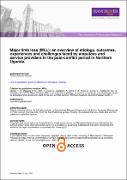Major limb loss (MLL): An overview of etiology, outcomes, experiences and challenges faced by amputees and service providers in the post-conflict period in Northern Uganda
| dc.contributor.author | Okello, Tom Richard | |
| dc.contributor.author | Magada, Samuel M | |
| dc.contributor.author | Atim, Pamela | |
| dc.contributor.author | Ezati, Daniel | |
| dc.contributor.author | Campion, Alice | |
| dc.contributor.author | Moro, Emmanuel B | |
| dc.contributor.author | Huck, Jonathon | |
| dc.contributor.author | Byrne, Ged | |
| dc.contributor.author | Redmond, Anthony | |
| dc.contributor.author | Nirmalan, Mahesh | |
| dc.date.accessioned | 2021-05-12T10:28:52Z | |
| dc.date.available | 2021-05-12T10:28:52Z | |
| dc.date.issued | 2019 | |
| dc.identifier.citation | Okello, T. R., Magada, S. M., Atim, P., Ezati, D., Campion, A., Moro, E. B., Huck, J., Byrne, G., Redmond, A., & Nirmalan, M. (2019). Major limb loss (MLL): An overview of etiology, outcomes, experiences and challenges faced by amputees and service providers in the post-conflict period in Northern Uganda. Journal of Global Health Reports, 3, e2019028. https://doi.org/10.29392/joghr.3.e2019028 | en_US |
| dc.identifier.uri | https://doi.org/10.29392/joghr.3.e2019028 | |
| dc.identifier.uri | https://hdl.handle.net/123456789/250 | |
| dc.description.abstract | Background Trauma is a leading cause for major limb loss (MLL) during war. As societies transition into peace other factors become important. The voluntary sector plays a diminishing role in service delivery as countries transition towards peace. Methods We undertook a retrospective review of 141 inpatient case notes at two hospitals in Northern Uganda to study the etiology of MLL. Focus group discussions, a literature search and key informant interviews were undertaken to ascertain patients’ experience and the state of current services. Results The most common indication for amputation was malignancy (36%), followed by gangrene and complications from diabetes. Trauma was the 5th most common cause. The mean (standard deviation, SD) age of this cohort was 43 (22.2) years and the mean (SD) distance from their homes to the closest rehabilitation service unit was 91 (75) km. Less than 1% of patients were formally referred to rehabilitation services. Patients described experiences of stigma and marginalization impacting relationship and/or employability. Rehabilitation services were limited/ unaffordable and inaccessible. Unpreparedness of government agencies in taking over rehabilitation services was evident. Conclusions Non-communicable diseases account for the majority of MLL in this region now. These new cohorts of patients join an existing large pool of war-related amputees. Chronic dependence on the voluntary sector has rendered a state of unpreparedness amongst the local health providers. | en_US |
| dc.language.iso | en | en_US |
| dc.publisher | Journal of Global Health Reports | en_US |
| dc.subject | etiology | en_US |
| dc.subject | Northern Uganda | en_US |
| dc.subject | Post conflict period | en_US |
| dc.subject | Major limb loss | en_US |
| dc.title | Major limb loss (MLL): An overview of etiology, outcomes, experiences and challenges faced by amputees and service providers in the post-conflict period in Northern Uganda | en_US |
| dc.type | Article | en_US |
Files in this item
This item appears in the following Collection(s)
-
Research Articles [34]

